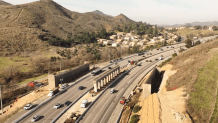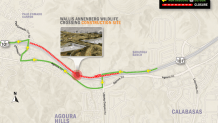
Construction work for the Wallis Annenberg Wildlife Crossing in Agoura Hills is expected to enter a new phase next month with the installation of concrete beams, which would require Caltrans to shut down the 101 Freeway every night for more than a month.
Crews are building two concrete walls on either side of the freeway near the Liberty Canyon Road exit and erecting columns in the median on the freeway.

And starting in mid or late April, Caltrans will install “the large-scale concrete beams that will be the first horizontal support for the crossing,” according to the National Wildlife federation.
Get San Diego local news, weather forecasts, sports and lifestyle stories to your inbox. Sign up for NBC San Diego newsletters.
“With the placement of the horizontal supports, the structure is truly going to start looking like the bridge it will become,” said Beth Pratt, California Regional Executive Director for the National Wildlife Federation in a statement.
While this major project goes on for 30 to 45 days, all lanes in one direction of the 101 Freeway will be closed overnight.
Where the closures will take place
U.S. & World
Highway 101 will be closed in Agoura Hills between Liberty Canyon Road and Chesebro Road.
When the closures will happen
All lanes will be closed in one direction Monday through Friday from midnight to about 5 a.m. The closures will last for 30 to 45 days, starting in mid or end April.
Some freeway lanes may begin closing as early as 7 p.m. on certain days.
While one direction will be completely closed, lanes in the opposite direction will stay open for traffic.

Detours
Drivers passing through Agoura Hills could use a detour on local streets via Agoura Road, Liberty Canyon Road and Chesebro/Palo Comado Canyon Road.
Caltrans warns against using State Route 126 as a detour during the construction.

What is the Wallis Annenberg Wildlife Crossing?
The Wallis Annenberg Wildlife Crossing project began on Earth Day, April 22, with a ceremonial groundbreaking setting it on a path for completion in 2025.
The greenspace bridge will provide more room to roam for mountain lions and other animals hemmed in by urban sprawl. Big cats, coyotes, deer, lizards, snakes and other creatures will have a safe route to open space in the Santa Monica Mountains and better access to food and potential mates.
It is estimated that the mountain lion population in the Santa Monica Mountains could become extinct within 50 years without an influx of genetic diversity. The lions are largely isolated due to freeways that act as barriers to movement across the region.
Conservationists hope the $85 million crossing will alleviate the problem.
More than 6,100 tons of concrete and over 426 tons of bar reinforcing steel have been used to create the walls and the columns, according to the National Wildlife federation.



